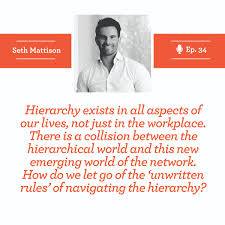As someone who’s been in the education field for more than 35 years, I’ve worked with my fair share of exceptional leaders as well as those who were not so great. What differentiated the two primarily were the actions that they took on a daily basis and the foundation of their beliefs. How I, and others, evaluated them as leaders remained basically the same throughout all of that time; did they possess and practice honesty, integrity, creativity and innovation, delegation and authority, commitment, and the ability to inspire others.
But in today’s rapidly changing world, two noted authors are questioning what the main focus of a great leader should be. As Elon Musk said, “The world you know will change faster over the next five years than the past fifty.” That’s a sobering and exciting challenge for leaders.

The Premise of the Book
In Seth Mattison and Joshua Medcalf’s fable The War at Work: A Tale of Navigating the Unwritten Rules of the Hierarchy in a Half Changed World, they provide an insightful examination of the best ways for organizations to reinvent themselves for the future.
The book is written about a corporate executive who has risen to his high rank in the organization by following long-established rules and norms, both written and unwritten. However, once in his coveted position, he realizes that what he has always known and done is no longer working, even though he is not sure why.
Mattison bases the book on this premise from Deloitte Insights:
“In the last two years of our global research, the most important human capital trend identified by our survey respondents has been the need to break down functional hierarchies and build a more networked, team-based approach.”
The future is being defined by two forces that are battling each other: hierarchies and networks. We are in the age of the network (networks of resources, talents, IOT, etc.). This fights with our traditional world of hierarchy, of org charts and rules and expectations and of how things are supposed to be done. Hierarchy provides a lot of security, stability, and clarity, but very little freedom. Network provides freedom, but ambiguity and uncertainty as things move and change very fast, which can be frightening.
“Organizational structures are mirrored in our assessments, thinking, and mental models. They form the basis for our understanding and the nature of our reality.” Peter Senge, MIT Sloan School of Management (The Fifth Discipline). Hierarchy has re-wired our brains. This is a problem because Millennial and Generation Z adults are working on a networked model since that’s what they grew up with.
What Leaders Should Do Now
I was fortunate to be able to attend an all-day session with Seth Mattison and found his ideas really intriguing, both for TCEA and for school districts. He made the point that great leaders today must maintain a foot in the two worlds (hierarchy and network) every single day. They can live in the present moment and execute results there. But they also must simultaneously reinvent and experiment to see what is coming next.
In thinking about our educational system, we are firmly entrenched in the hierarchy model today with lots of boxes and rules and “that’s the way we’ve always done it.” And, of course, it can be argued that we don’t have complete control over what happens at school each day with rules and regulations from the Legislature, TEA, SBOE, and SBEC. But regardless, I think true leaders should be busy questioning the structure of everything we do in order to remain relevant in the future.
How Leaders Can Bridge the Gap
Here are some ways that Mattison believes we can bridge the gap between hierarchies and networks.
- Process – All the processes and procedures that are in place must change if they are not the most effective way to deliver learning. That means not being afraid to question everything. It also means that we must use agile methodologies and design thinking on a regular basis as leaders.
- Technology – With all of the tech available to us as leaders, we can unleash networking pieces into our hierarchical structure. Consider the TCEA Community, as one example, of a place where people can connect without a hierarchy or rules. There’s also the power of a program like Slack, which connects people 24/7 and provides a way for ideas to be generated and discussed.
- Experience – Joseph Pine created the theory of the “experience economy,” the belief that as a society, we came from a commodities good’s-based economy to a service-based economy to an experience-based economy today. A good example of this movement is when a family member is going to celebrate a birthday. In the past, we bought ingredients (flour, sugar, eggs, etc.) to make them a cake. As time went on, we came to buy a boxed cake mix to make for them. Next, we outsourced the birthday party experience to Chucky Cheese. Our appetite as a society for better experiences has escalated and grown. We will pay more for a discretionary effort now, which is when someone provides something that is not expected (creating amazement). So how do we provide discretionary effort to provide a better work experience for our staff and our students?
- Skills – This is the single most important leadership skill today: future-casting (the ability to collectively establish and then transparently cast a clear and compelling vision of the future). It establishes trust and confidence in the future of the organization. Leaders need to share our vision more with all staff, students, parents, and the community. This includes what we are trying to accomplish shared in a clear and compelling way.
As a leader, what are you doing today to bridge the gap between hierarchies and networks? How are you sharing the vision that you have with your stakeholders? How are you creating a better learning experience for students and a better work experience for staff? What networking technologies have you put into place to empower your team? How have you evaluated all of the processes that drive us every day?
I would love to have a conversation about this with you. Please join me for a free Zoom sharing on Tuesday, April 30 from 1:30 to 2:30 CDT. No registration is required. I’d love to learn with you about this important topic!

